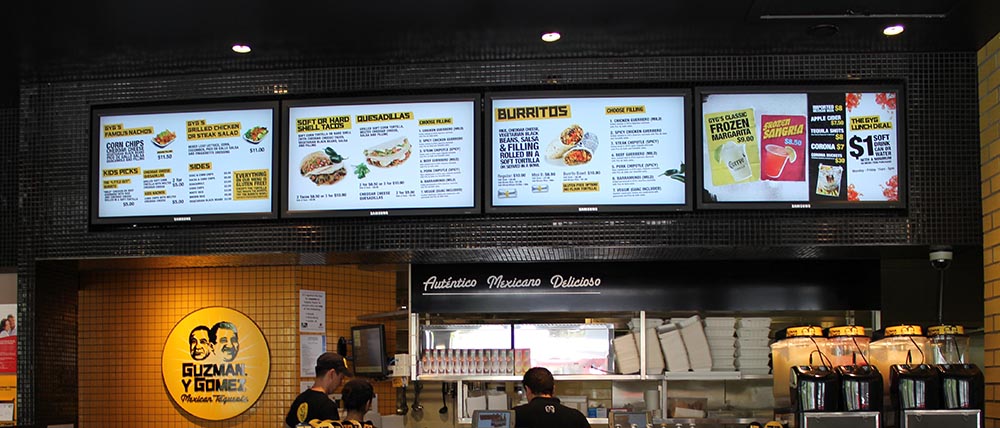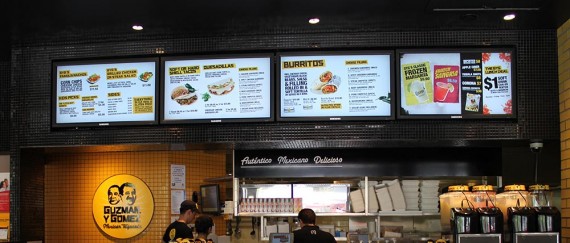Guzman y Gomez leads the QSR field with a long-view approach to dynamic signage.
Story: Christopher Holder
You should meet the co-founder of Guzman y Gomez, Steven Marks. He’s a loud-mouthed, fast-talking New Yorker… and, I hasten to add, instantly charming.
Steven Marks and Robert Hazan scouted Australia about 10 years ago, and discovered something any Aussie over the age of 20 already understood instinctively: Mexican food in Australia is all about packet mixes, refried gloop rolled into different shapes, syrupy daiquiris, and cornball ‘holy frijoles’ Mexican cliches.
Guzman y Gomez filled the void with simple, authentic Mexican cuisine that fairly leaps off the plate with freshness. The Australian public has responded enthusiastically, allowing GYG (as the restaurant is affectionately known) to expand at a Speedy Gonzales rate — 24 locations at last count. (In fact, as you read this, GYG will have its flagship World Square restaurant opened in Sydney.)
STRONG FLAVOUR
GYG’s brand is strong. The eponymous (and fictional) Messrs Guzman and Gomez have characters all their own, and the sassy attitude flows freely throughout the organisation — from the CEO down to the tomato chopper in a franchised outlet. Little wonder then that head office is committed to keeping its brand fresh and exciting. Technology plays a significant role, having recently installed a sophisticated digital signage network, designed by Daraco IT.
DigitalSignage had a chat to Guzman y Gomez CFO Robert Hazan about the grand plans for the network, and how he came to make the investment: “It’s great to change the menu board artwork when we need to — I’m not downplaying the importance of that — but I think we really want to take our digital signage to a whole other level.”
GETTING THE TECH RIGHT
Sounds intriguing! I thought we’d find out some more about the technical back-end goodness that promises so much, from Daraco IT Services’ David Cox.
David Cox: Back when there were only five GYG outlets we identified that technology was going to be central to the rollout of the restaurants. We had conversations about the internet connection, which led to the request to play in-store music, and the capacity to centralise the data and deliver it out to the other outlets — which we did. That then evolved into an exploration of what we could do with the digital signage — namely, a central repository to update the stores in a dynamic way.
Robert Hazan: I love technology and I wanted to resource our restaurants to be ahead of the curve. By which I mean, when we have the ideas, it’s a simple case of hitting the ‘go’ button — the technology wouldn’t let us down. And believe me, those ideas are happening, so I just wanted to build the restaurants in a way such that when the ideas arrived we’d be ready to roll, remembering that once you’ve fit out a restaurant, then re-cabling it is not an easy task.
UNCONVENTIONAL
As at the time of going to press, Robert was tight lipped about the exact nature of his big ideas — “let’s just say, the results will be unconventional”. The network as it stands, with its gorgeous army of hi-def commercial Samsung large-format panels, looks fabulous but isn’t breaking any ‘rules’.
Robert Hazan: At the moment I could be using a $90 Western Digital media player for what we’re doing. But that’s soon going to change. Sending people around restaurant to restaurant to change media is expensive, or putting SD cards in the mail, that’s a thing of the past. The Spinetix media players afford us full networkability and we’ll be able to tailor our message restaurant-to-restaurant, screen-to-screen and hour-to-hour if we want to. They’re not cheap, but I think in technology you get what you pay for.
THE POSSIBILITIES
So what’s so special about the Spinetix HMP200? It’s compact (easily mounting to the screen if needs be), it’s non-PC based, has no moving parts and requires zero maintenance. It’s been designed to display full HD video combined with multiple live news feeds and animations. After Robert explained what the network was packing, he found the eyes of his ‘creatives’ lighting up.
Robert Hazan: We work with some really talented creatives. When I told them what these players are capable of you could immediately see the cogs turning. For example, we have a Head of Food Innovation, who’s based in California and going on a ‘taco tour’ of Mexico. It’s not hard to imagine how we could be streaming his experiences on one of the restaurant screens during the day. You can see the ideas going on their heads when you tell them the functionality available.
TAKING THE LEAD
If you’re thinking Robert will be taking his lead from looking at what quick service restaurants (QSRs) are doing in his native New York, then think again:
Robert Hazan: New York is well ahead of the game in so many regards. But QSR hasn’t adopted digital signage in the US with any degree of sophistication. There aren’t a lot of exciting brands out there. Take Chipotle, for instance. Chipotle is the best and the biggest in our field but from a menu board perspective they keep it really, really simple. I find inspiration in areas outside the QSR market. I’m looking at the creative use of digital signage and thinking about how to apply it in GYG.
HOT RIGHT NOW
QSR is clearly a huge market where good digital signage can truly shine. The focus has always been on menu boards, and fair enough too, as digital menu boards provide an easy answer to flipping from a brekky menu to a lunch menu, and with the ability to change pricing on a cyclical basis or a day part ‘happy hour’ basis, digital signage is a no-brainer.
It’s exciting to anticipate what GYG has in store. I’ve no doubt the strategy will be a world-leader in this sector. But remember, none of this is ‘look at me’ vanity, it’s all rooted in sound commercial practice, namely, making money. Or as Robert Hazan put it: “Everything is about driving sales. It might be a great-looking creative campaign, but it’s still all about sales.”


